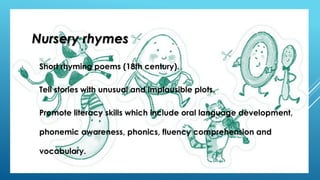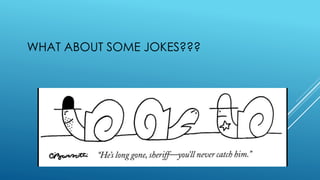Critical thinking and puns
- 1. SOME CRITICAL JOB TO DOŌĆ”. Monik Vinueza Universidad T├®cnica del Norte 2015
- 2. THIS IS THE PLANŌĆ” 1. Do the KWL chart 2. Review a definition of critical thinking 3. Explore the proposal 4. Get some ideas
- 3. WHAT DO YOU KNOWŌĆ”.? What is critical thinking? How can we develop in class? Can it be done? Results?
- 4. TWO DEFINITIONSŌĆ” ’éä Beyer (1985) ability to gather, evaluate and use information effectively. ’éä It involves thinking skills: judging, posing and solving problems ’éä Smith (1990) reflecting , arguing, and propoing different alternatives of solution ’éä It means ŌĆ” not taking everything for grantedŌĆ”ŌĆ” ’éä Open your eyes ’éä Develop skills ’éä Activate your curiosity, motivation and mental skills
- 6. SOME DEFINITIONSŌĆ”.. ’éä Riddles ’éä Nursery rhymes ’éä Puns ’éä Funny anagrams ’éä Jokes ’éä Oxymorons
- 7. A riddle is a statement or questionor phrase having a double or veiled meaning, put forth as a puzzle to be solved. Examples: 1. Which month has 28 days? All of them of course! 2. What five-letter word becomes shorter when you add two letters to it? Short
- 8. MORE RIDDLESŌĆ”ŌĆ” 1. What word begins and ends with an ŌĆśeŌĆÖ but only has one letter? 2. What has a neck but no head? 3. What gets wetter as it dries?
- 9. 4. Why did the boy bury his flashlight? 5. Which letter of the alphabet has the most water? 6. What starts with a ŌĆśPŌĆÖ, ends with an ŌĆśEŌĆÖ and has thousands of letters? 7. What has to be broken before you can use it?
- 10. ANSWERSŌĆ” TO THE RIDDLES 1. Envelope 2. A bottle 3. A towel 4. Because the batteries died. 5. The C 6. The Post Office! 7. An egg
- 11. Nursery rhymes ’éä Short rhyming poems (18th century). ’éä Tell stories with unusual and implausible plots. ’éä Promote literacy skills which include oral language development, phonemic awareness, phonics, fluency comprehension and vocabulary.
- 12. HERE IS AN EXAMPLEŌĆ”. ’éä What might be all the ways to keep Humpty Dumpty from falling off the wall? ’éä In what ways might the KingŌĆÖs men put Humpty Dumpty back together again? ’éä How might the KingŌĆÖs men reach Humpty Dumpty before he falls? ’éä How might you prevent Humpty DumptyŌĆÖs shell from breaking? ’éä How might you lessen the damage of Humpty DumptyŌĆÖs fall? Humpty Dumpty sat on a wall; Humpty Dumpty had a great fall. All the KingŌĆÖs horses And all the KingŌĆÖs men CouldnŌĆÖt put Humpty together again!
- 14. OTHER NURSERY RHYMES ’éäLittle Miss Muffet Little Miss Muffet sat on a tuffet Eating her curds and whey, Along came a spider, Who sat down beside her And frightened Miss Muffet away.
- 15. Old King Cole was a merry old soul, and a merry old soul was he; He called for his pipe in the middle of the night And he called for his fiddlers three. Every fiddler had a fine fiddle, and a very fine fiddle had he; Oh there's none so rare as can compare With King Cole and his fiddlers three. http://www.rhymes.org.uk/old_king_cole.htm
- 16. PUNSŌĆ” ’éä A form of word play which take advantage of words, or similar sounding words, with multiple meanings, often to create a humorous situation or joke. ’éä Puns can sometimes be created unintentionally, in which case the saying ŌĆśno pun intendedŌĆÖ is used. ’éä For example: ’éä LetŌĆÖs talk about rights and lefts. YouŌĆÖre right, so I left. http://www.funnyjunk.com/
- 17. EXAMPLESŌĆ” 1. When a clock is hungry it goes back four seconds. 2. Without geometry, life is pointless 3. Time flies like an arrow. Fruit flies like a banana. 4. She had a photographic memory but never developed it. 5. Two antennas met on a roof, fell in love and got married. The ceremony wasn't much, but the reception was brilliant!
- 18. What is a pun? Why is this a pun? What is a spelling bee? How can you develop critical thinking through it?
- 19. How can you use this pun in class? What are the possible questions that can be formulated? Are images important?
- 20. FUNNY ANAGRAMS A word, name or phrase formed by rearranging the letters of another, using each original letter only once. The best anagrams manage to link the new word, name or phrase to the original one in some way, such as when ŌĆślistenŌĆÖ becomes ŌĆśsilentŌĆÖ or ŌĆśElvisŌĆÖ becomes ŌĆślivesŌĆÖ.
- 21. EXAMPLESŌĆ” 1. A gentleman = Elegant man 2. Eleven plus two = Twelve plus one 3. Hot water = Worth tea
- 23. WHAT ABOUT SOME JOKES???
- 25. (1)"I am not surprised," replied the weary salesman, (2) A man went to a shoe-shop to buy shoes. (3) Finally, he was satisfied. (4) He put many pairs on his feet. (5) "They are your own shoes.ŌĆ£ (6) "At last," he said, "I have found a pair of shoes that fit me." SOME JOKES????
- 26. Elementary: Why didn't the skeleton go to the party? Because he had no-body to go with! Intermediate: How do you count a herd of cattle? With a cowculator.
- 27. This is a story about four people named Everybody, Somebody, Anybody and Nobody. There was an important job to be done and Everybody was sure that Somebody would do it. Anybody could have done it, but Nobody did it. Somebody got angry about that, because it was Everybody's job. Everybody thought that Anybody could do it, but Nobody realized that Everybody wouldn't do it. It ended up that Everybody blamed Somebody when Nobody did what Anybody could have done.
- 29. Advanced (1) What did the mayonnaise say to the fridge? Close the door please. I'm dressing. (2) What's round and dangerous? A vicious circle! (3) A: Shall I tell you a secret about butter? B: You'd better not. I might spread it.
- 30. BIBLIOGRAPHY. ’éä Using Nursery Rhymes to Boost Your/Your ChildŌĆÖs Creative IQ http://alicia-arnold.com/2011/03/30/using-nursery-rhymes-to-boost- your-childs-creative-iq/ ’éä /www.google.com.ec/ ’éä http://philosophy.hku.hk/think/logic/puzzles.php ’éä https://www.englishclub.com ’éä http://www.onestopenglish.com/community/lesson- share/extras/teenagers/teenagers-lateral-thinking/145220.article ’éä https://neltachoutari.wordpress.c http://iteslj.org/Techniques/Kabilan-CriticalThinking.html om/2011/11/01/critical-thinking-in-esl-classrooms/
- 31. CRITICAL THINKINGŌĆ”FACTS TO CONSIDER.. ’éä Critical thinking, like many other phenomena, has been defined variously by many scholars. ’éä Critical thinking, a hard-to-define concept, has philosophical and psychological roots (Lewis & Smith, 1993). ’éä Critical thinking refers to a type of lateral thinking that enables individuals to analyze and evaluate information about a situation or phenomenon or a problem and to make appropriate decisions that befit in their contexts. ’éä The third approach to critical thinking is within the field of education (Sternberg, 1986). ’éä Critical thinking is not an easy concept to define as it can mean quite different things to different people in different contexts and cultures. ’éä It takes time to develop ’éä Generally speaking, to think critically about an issue is to consider that issue from various perspectives, to look at and challenge any possible assumptions that may underlie the issue and to explore its possible alternatives.
- 32. TO SUM UP.. ’éä Critical thinking in EFL teachingŌĆ”.. ’éä Based on the study of King (1995) and Taba (1966), the level of studentsŌĆÖ thinking is strongly influenced by the level of questions which are asked in class. ’éä According to the study of Paul and Elder (2001), critical thinking can be defined as a mode of thinking about any subject, content, or problem. ’éä ŌĆ£Critical thinking includes the component skills of analyzing arguments, making inferences using inductive or deductive reasoning, judging or evaluating, and making decisions or solving problemsŌĆØ

































